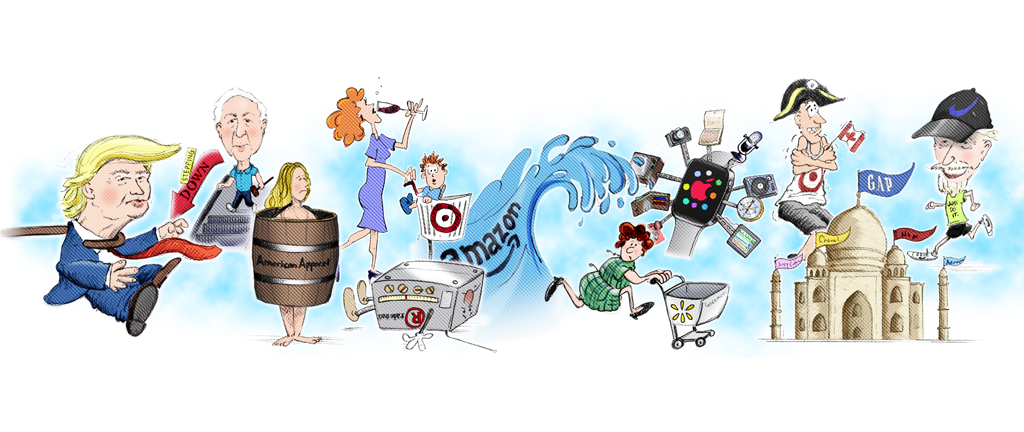The world continued to redefine “retail” in 2015, from a building where customers went to shop, to a device allowing consumers to shop from wherever they happened to be.
Some traditional retailers are artfully making the transition. Many are stumbling. Brands have become their own retailers, and many entrepreneurs are selling goods all over the world without hiring a single store designer.
Like any other year in the history of retail, many other things happened, too, like the biggest product launch in history, at least since the last Apple product launch. The international market continued to widen for some and trip others up, and some retailers covered their windows and closed their doors for the last time.
Most shockingly, a couple of retail icons exited stage left, leaving a gaping void that no digital programming entrepreneur could ever fill.
Style Weeps
In October, Ralph Lauren announced he would be stepping down as ceo of Ralph Lauren Corp.
The story is familiar. In the ’60s, the boy from the Bronx “schlepped” his ties around New York. He began opening Polo stores in the ’70s, reinvented visual merchandising in the ’80s (who can forget Macy’s multicolored Polo wall?), reinvented brand-extension shops in the ’90s, and introduced classical romance to his flagship stores.
Advertisement
His replacement will be Stefan Larsson, currently the ceo of Old Navy, formerly with H&M. It is said by many news outlets that Larsson has successfully revived and grown businesses. But can he invoke a Wyoming vista or a Long Island sunset?
Branding Stumbles
This summer, Phil Knight announced he would step down as chair of Nike, the company and brand he founded 51 years ago.
A runner at the University of Oregon, Knight and his track coach, Bill Bowerman, had an idea for a new kind of running shoe. Nike has since gone from brand of shoe to a brand of living, all compacted into a ubiquitous piece of logo artwork – in a word, the “swoosh.”
A generation was told to “just do it,” and everyone knew from where that message emanated: Phil Knight, lapping the rest of the field.
Watch Out!
In June, after months of waiting, Apple began selling its Apple Watch. Opening bids were from $349 to $10,000 for a limited-edition gold model.
It’s the watch that’s simultaneously a handheld computer and smartphone, a music player and a bill payer, a message-notifier and a heart monitor, an appointment calendar and a workout device, a navigation system and a reservation-maker – and don’t forget about Siri.
Advertisement
Amazingly, it also tells time.
In late October, rumors surfaced that the company would launch an Apple Watch 2 in 2016. Oh, Apple, you breaker of hearts and dreams.
Someone Else has ‘Lower Everyday Prices’
Moms and pops around the country are smiling this year: In October, Walmart Stores Inc. – once the scourge of the small independents – was “scourged” itself.
The retail giant reported that growth over the next three years would be an anemic 3 to 4 percent and profit would drop up to 12 percent in fiscal 2017. Walmart shares tumbled, and its investors saw $21.5 billion in market value vanish in just one day.
The problem: The Amazon tsunami finally made landfall; Walmart is no longer the go-to for price-sensitive shoppers.
Turn Off the Radio
There was probably no surprise in February when RadioShack finally declared bankruptcy, only sadness.
Advertisement
RadioShack was so intricately entwined in our lives that it took eight months to sort out the affairs of a company that was 95 years old and had 4000 stores.
It’s safe to say there’s a vacant space in most American malls and a silent spot on the dial.
An American Tragedy
After years of walking on the edge, American Apparel lost its step, filing for bankruptcy in October. Its hipper-than-hipster duds finally fell out of favor, or maybe its clientele got tired of the controversy – and hypocrisy.
Despite claims on its own website that “American Apparel garments are created by motivated and fairly paid employees who don’t just have jobs – they have careers,” a series of controversies surfaced surrounding sexual harassment, assault, employment of unauthorized workers, exploitation and a worker’s death. American Apparel ads have even been banned in the U.K. for “gratuitous nudity.”
As Alexandra Petri, a blogger for The Washington Post, said, “In an American Apparel store, I asked myself, ‘Where did I last see people dressed like that? Oh yeah. In an ad for American Apparel.’ ”
Darjeeling Limited: All Aboard
The Indian market, closed to Western retailers and brands for so many decades, opened with a flourish of silk and saris – also leopard prints and faux fur.
Among the Westerners rushing into the mysterious subcontinent this year were: Bulgari and BCBG Max Azria in New Delhi’s DLF Emporio Mall (currently home, as well, to Armani, Christian Louboutin, Bottega Veneta, Christian Dior and Chanel); Gap and H&M in the Select Citywalk mall in South Delhi’s Saket area; Juicy Couture in Gurgaon’s Ambience Mall; and Aéropostale and its newly signed licensing agreement to open stores throughout India.
Also, IKEA and Reebok both announced they’d be expanding their current Indian presence.
India is dense and forbidding, but it’s a $4 trillion market of 2 billion people, with a surging middle class. The shops are chic, but be cautious of the drinking water.
And don’t miss the Taj Mahal: There might be a Gap store there soon.
No Trump
In July, Macy’s announced it would pull Donald Trump-brand merchandise from its stores after he declared his candidacy for the Republican nomination.
There were probably aspects of the Federal Election Commission’s fairness rules in there somewhere, but the retailer said it was primarily responding to protests from MoveOn.org and others about Trump’s infamous statements about Mexican immigrants.
Trump thus became the first presidential candidate to have his branded merchandise pulled from stores.
Have Some Madeira, My Dear
Target applied for two liquor licenses for a new store in Chicago’s Streeterville neighborhood. If approved, Target would be allowed to sell alcohol for in-store consumption and could offer packaged alcohol for purchase.
Why? The retailer has offered no further explanation – not even whether the drinks will be served in commemorative Michael Graves glassware.
But Not Canadian Stratus White 2006
Target finally pulled the plug on its Canadian venture, closing the last of its 133 stores there in April.
In January, Target Canada was granted court protection from its creditors, claiming it couldn’t make a profit for at least another five years.
Target Canada shut down operations a month early, prompting Customer Strategy Advisor, Mark Satov, to comment to CBC News: “What are they going to stay around for if they’re not … generating cash? They don’t care about the goodwill. Let’s go home and move on.”
Ouch!
Napoleon could have warned you, Target. Never venture into wintry climes. Stay home, where it’s comfortable and warm – in Minneapolis.


 Photo Gallery7 days ago
Photo Gallery7 days ago
 Headlines6 days ago
Headlines6 days ago
 Headlines1 week ago
Headlines1 week ago
 Headlines2 weeks ago
Headlines2 weeks ago
 Headlines1 week ago
Headlines1 week ago
 Designer Dozen2 weeks ago
Designer Dozen2 weeks ago
 Special Reports2 weeks ago
Special Reports2 weeks ago
 Designer Dozen5 days ago
Designer Dozen5 days ago















